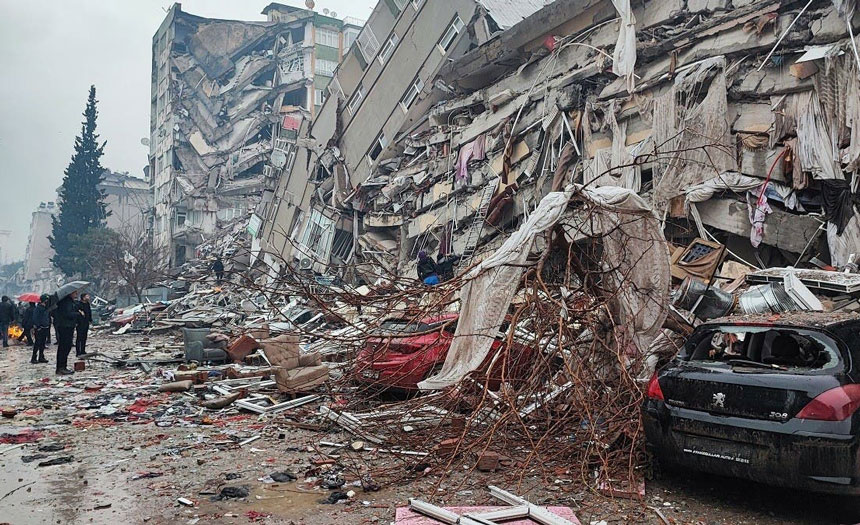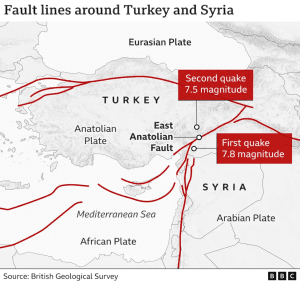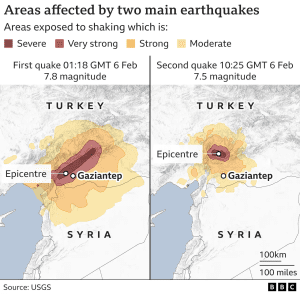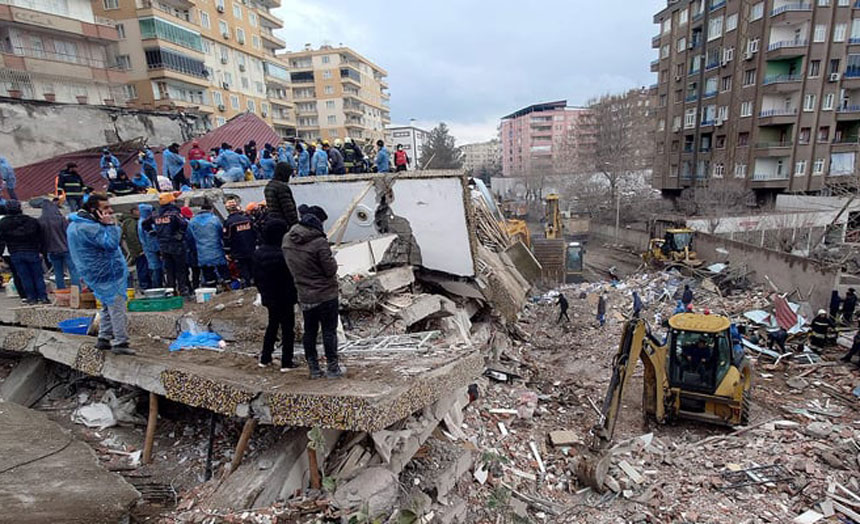By: Hanieh Maleki
In the early hours of Monday morning 5th Feb, a huge earthquake struck south-eastern Turkey, near the Syrian border, killing tens of thousands of people and injuring scores more. The depth of the disaster became more tangible when Turkish Vice President Fuat Oktay told reporters that 80,000 people were receiving treatment in hospitals and 1.05 million people were in temporary shelters as a result of the quakes. For now, eight days after Turkey’s worst earthquake in modern, Rescuers still working even through nights to save lives however, hopes of finding many more survivors are fading because of cold weather, and lack of food and water for survivors beneath the rubble.
Here is more about Turkey’s earthquake .
The death toll in Turkey is 31,643, while in Syria it is over 5,700 including those who died in both the rebel enclave and government-held areas. After the 2005 Pakistan earthquake that killed at least 73,000, it is the sixth most deadly natural disaster of this century. In 10 cities, some 42,000 buildings have collapsed, need demolition, or are severely damaged, according to Turkey’s Urbanization Minister Murat Kurum.
Several residents and first responders told Reuters they were astonished at the lack of water, food, medicine, body bags, and cranes in the disaster zone in the days following the quake, and many criticized Turkey’s Disaster and Emergency Management Authority (AFAD) for its slow and centralized response.). As they put it, “People died not because of the earthquake, but because precautions were not taken earlier,”. In this regard, the Turkish president acknowledged the problem prior to an election scheduled for June, which is expected to be the toughest in his two decades at the helm.
Scientists from the UK Centre for the Observation & Modeling of Earthquakes, Volcanoes & Tectonics (COMET) compared satellite images of the area near the Mediterranean Sea coast before and after the massive earthquakes and found Two gigantic cracks in Earth’s crust opened near the Turkish-Syrian border after two powerful earthquakes. In some cases, cracks can be seen running through towns and directly through buildings as a result of the movement of the tectonic plates. 190 miles (300 kilometers) of the longer rupture extends northeastward from the Mediterranean’s northeastern tip. It was caused by the first of two major tremors that struck the region on Monday, the 7.8-magnitude earthquake that struck at 8:17 p.m. EST on Feb. 5. Approximately nine hours later, a milder 7.5-magnitude quake opened the second crack (125 km).
COMMET scientists say that It often happens after strong earthquakes that such breaks occur. following this, earthquakes also release enormous amounts of energy through these rifts. In general, the bigger the earthquake, the bigger the fault and the more it shifts. however, they are shocked as It is the longest earthquake fault ever recorded in a solid. Also, it is very rare to have two earthquakes of this magnitude within a short period of time.” they pointed out.
Taking advantage of the suffering of the earthquake victims has also opened the door for fraudsters. The earthquakes in Turkey and Syria are being used by scammers to deceive people into donating to fake causes. some content producers are posting videos and photos of the devastation on some social networks, including TikTok Live, caused by the earthquake, looped videos and TV recordings showing the efforts of rescue teams, with subtitles including phrases such as “Let’s help Turkey”, “Pray for Turkey” and “Donate for earthquake victims” to deceive people by asking for financial aid. As a result, scammers divert donations from real charities to their own PayPal accounts and cryptocurrency wallets instead of helping those in need.
Figure 1Aerial view shows cracks in the ground in the aftermath of a deadly earthquake, near the Tevekkeli village in Kahramanmaras, Turkey February 10, 2023. REUTERS/Issam Abdallah
On the other hand, UN Secretary-General Antonio Guterres said on Monday that Syrian President Bashar al-Assad has agreed to allow UN aid deliveries through two border crossings from Turkey for three months. As a result of Assad’s decision, Bab Al-Salam and Al Ra’ee crossings can now be opened. This action follows the death of more than 37,000 people in an earthquake that struck Turkey and Syria a week earlier. After Assad’s agreement, the United Nations could now access northwest Syria via three border crossings from Turkey. “By opening these crossing points, facilitating humanitarian access, accelerating visa approvals, and easing travel between hubs, more aid will be delivered faster,” Guterres concluded. As part of this effort, Syrian UN Ambassador Bassam Sabbagh confirmed that Syria would support humanitarian aid deliveries through all possible routes from Syria or across the border for a three-month period. Syria and the UN had reached an agreement, he told reporters.
The important point that should be noted in the meantime is that the disasters overlap with what happened in Syria due to the earthquake. Those who live on the Syrian side may have been displaced due to the country’s more than ten-year civil war and lived in very difficult conditions before the earthquake, but they also have one life and can be survivors of the earthquake.
A total of 1.7 million people live in this region of Syria opposing President Assad’s rule, living in makeshift camps and newly constructed shelters. It is a place of resistance against Bashar al-Assad’s rule. As a result of Turkish protection, it is controlled by Hayat Tahrir al-Sham (HTS), an Islamist group that was once affiliated with al-Qaeda. The group has cut links with Syrian government, and almost all governments in the world have no relations with them. Therefore, Apart from a few Spanish doctors, no international aid teams have reached this part of Syria.
It appears that no one has been paying attention to survivors of the earthquake in this area, who have been asking for international aid since the first hours after the earthquake. Doctors at Bab al-Hawa Hospital (the only hospital serving residents of the area), which is supported by the American Syrian Medical Association, said they could not comment further on the humanitarian response in the area. Although the Syrian Civil Defense Force – also known as the White Helmets – which operates in opposition-held areas, did what they could with pickaxes and crowbars, doctors believe that the depth of the disaster after the earthquake in this region will be very terrible. According to the testimony of the survivors and due to the lack of debris removal equipment and tools, medicine, water, food, clothes, heating devices, ambulance, and equipped medical centers, many lost their lives even those that were pulled out from under the rubble.
What made it so deadly?
The first earthquake measured 7.8, which is classified as a “major” earthquake. Buildings along the fault line were seriously damaged by the earthquake, which occurred along a fault line of about 100km (62 miles). However, the combination of several factors led to an increase in casualties and the occurrence of this great disaster. In the last 10 years, only two earthquakes of equivalent magnitude have occurred in a given year, and four in the previous ten years,” said professor Joanna Faure Walker of University College London’s Institute for Risk and Disaster Reduction. It is not just the power of the tremor that causes destruction. The incident occurred during the early morning hours when people were sleeping inside. It is also important to consider the durability of the buildings. Moreover, it is said that Since there had been no major earthquake in the region for more than 200 years, the level of preparedness would be lower than it would be for a region that was more used to earthquakes. Thus, Dr. Carmen Solana, a volcanology and risk communication reader at the University of Portsmouth, said: “The resistant infrastructure is unfortunately patchy in South Turkey and especially Syria, so the early 24 hours are crucial to finding survivors. After 48 hours the number of survivors decreases enormously.”
What caused the earthquake?
The Arabian plate was moving northwards when it bumped into the Anatolian plate. It has caused very damaging earthquakes just as it did in the past because of the friction between the plates. Scientists are expecting the current earthquake to follow the same pattern as the previous big one in the region, which has already produced several aftershocks.
What are the measures of earthquakes?
They are measured on a scale called the Moment Magnitude Scale (Mw). This has replaced the better-known Richter scale, now considered outdated and less accurate. As a result of an earthquake, a number is assigned based on the distance and force involved in moving the fault line.
It is usually impossible to feel a tremor of 2.5 or less, but instruments can detect them. Up to five earthquakes may be felt and cause minor damage. According to the Turkish earthquake classification, a 7.8 magnitude earthquake causes serious damage, as can be seen in this case. The damage caused by anything above 8 can be catastrophic and can totally destroy communities.







